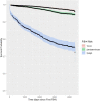The Association of Fibrosis-4 Index Scores with Severe Liver Outcomes in Primary Care
- PMID: 35048297
- PMCID: PMC9550951
- DOI: 10.1007/s11606-021-07341-z
The Association of Fibrosis-4 Index Scores with Severe Liver Outcomes in Primary Care
Abstract
Background: The Fibrosis-4 Index (FIB-4)non-invasively assesses fibrosis risk in chronic liver disease (CLD), but underdiagnosis limits FIB-4's application in primary care.
Objective: To evaluate the association of FIB-4 risk with hazard of severe liver outcomes in primary care patients with and without diagnosed CLD.
Design: Retrospective cohort study of primary care data from 2007 to 2018.
Participants: Adult patients with qualifying aminotransferase and platelet count results were included and a single FIB-4 score was calculated for each patient using the first of these values. Patients with a CLD diagnosis or outcome prior to their FIB-4 score were excluded.
Measures: FIB-4 advanced fibrosis risk categorization (low, indeterminate, and high) was the primary predictor variable. Patients were followed from FIB-4 score to a severe liver outcome, a composite of cirrhosis, liver transplantation, and hepatocellular carcinoma. We analyzed the association of FIB-4 risk categories with hazard risk of a severe liver outcome using stratified Cox regression models, stratifying patients by known CLD.
Key results: A total of 20,556 patients were followed for a mean 2,978 days (SD 1,201 days), and 4% of patients experienced a severe liver outcome. Of patients with low-, indeterminate-, and high-risk FIB-4 scores, 2%, 4%, and 20% suffered a severe liver outcome, respectively. In the overall adjusted model, high-risk FIB-4 scores were associated with hazard of severe liver disease (HR 6.64; 95% CI 5.58-7.90). High-risk FIB-4 scores were associated with severe liver outcomes for patients with known NAFLD (HR 7.32; 95% CI 3.44-15.58), other liver disease (HR 11.39; 95% CI 8.53-15.20), and no known CLD (HR 4.05; 95% CI 3.10-5.28).
Conclusions: High-risk FIB-4 scores were strongly associated with risk of severe liver outcomes in patients with and without known CLD. Comprehensive FIB-4 application in primary care may signal silently advancing liver fibrosis.
Keywords: Chronic liver disease; FIB-4; NAFLD.
© 2022. The Author(s) under exclusive licence to Society of General Internal Medicine.
Conflict of interest statement
The authors declare that they do not have a conflict of interest.
Figures



References
-
- Chalasani N, Younossi Z, Lavine JE, Charlton M, Cusi K, Rinella M, et al. The diagnosis and management of nonalcoholic fatty liver disease: Practice guidance from the American Association for the Study of Liver Diseases. Hepatology (Baltimore, Md.). 2018;67(1):328-357. 10.1002/hep.29367 - PubMed
-
- European Association for the Study of the L, European Association for the Study of D, European Association for the Study of O EASL-EASD-EASO Clinical Practice Guidelines for the management of non-alcoholic fatty liver disease. J Hepatol. 2016;64(6):1388–402. doi: 10.1016/j.jhep.2015.11.004. - DOI - PubMed
Publication types
MeSH terms
Substances
Grants and funding
LinkOut - more resources
Full Text Sources
Medical

